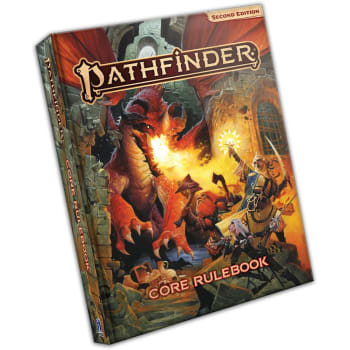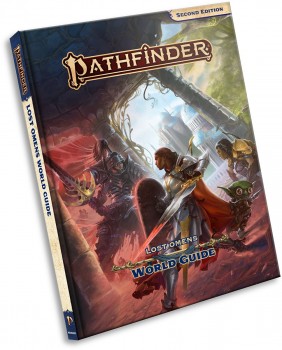Pathfinder Second Edition
 As has been the case for the last few years, this year’s big Gen Con release was from the folks at Paizo. Two years ago we got the release of Starfinder. Last year was the release of the Pathfinder Playtest. And this year the Pathfinder Playtest reaches its fruition with the release of Pathfinder Second Edition, released into the wild at the beginning of August.
As has been the case for the last few years, this year’s big Gen Con release was from the folks at Paizo. Two years ago we got the release of Starfinder. Last year was the release of the Pathfinder Playtest. And this year the Pathfinder Playtest reaches its fruition with the release of Pathfinder Second Edition, released into the wild at the beginning of August.
The gamer fanatics that we are here at Black Gate, we’ve been interested in this since Pathfinder Second Edition was first announced. Last fall, I covered the Pathfinder Playtest, and most of the basic game mechanics introduced in the playtest stayed constant in the Second Edition release, even if some of the specifics changed.
The pacing is one of the best aspects of Pathfinder Second Edition. The action economy of having three actions each turn, and different tasks taking different numbers of those actions, helps keep players and the gamemaster moving smoothly through the turns. Each character can track their most common actions, based upon their character build, so that they can easily keep track of their options in the action economy.
The character design in Pathfinder Second Edition is around accumulating feats – ancestry & heritage feats, class feats, general feats, and skill feats – that allow for a wide range of diversity. Some of these feats also unlock uncommon task types, which players without those feats aren’t able to access. This keeps the distinctive customization that has really become the hallmark of the Pathfinder RPG over the last decade.
One of the biggest game mechanics changes from First Edition, present in both the playtest and final Second Edition of the game, is the emphasis on critical successes and failures. Though critical hits have always been a feature of the game, Pathfinder Second Edition treats any roll that beats the target DC by 10 as a critical success and anything that falls short by 10 or more as a critical failure. Many effects and actions in the game have modified critical outcomes, not just attack damage.
It is fascinating to consider the early playtest and to look for which things did change. For example, one of the things that I found odd in the playtest was that even if you were Untrained in a skill, as you leveled up your modifier in it increased along with the level. Thematically it made no sense to me why someone who had never bothered to study something should get any better in it, or why an Untrained high-level Fighter would be better at Arcana than a Trained mid-level Wizard. Well, in the final version of the game, being Untrained in a skill provides no proficiency modifier at all.
The low modifiers for being Untrained combined with the stiff penalties for critical failures resulting from low rolls provide a substantial reason to get most useful skills up to at least a Trained level, or just to give up on even trying to roll them as you move into higher levels. If you’re a Wizard who is ever going to need to succeed a climb roll, it’s worth doing the occasional pull-up or working on their cardio program. Of course, a Wizard who doesn’t want to waste their research time on training the Athletics skill had better figure out a way to overcome the obstacle without relying on anything so mundane as an Athletics check.
If there’s one thing that has defined Pathfinder First Edition, it’s the massive amount of supporting material they release to support their game line. It is clear that to get their audience to switch over to Second Edition, they will need to release ample support materials to justify that change. Even in the first month, there’s been a massive amount of content and support materials released, all available through Paizo.com, online, or at your local gaming store:
- Pathfinder Second Edition Core Rulebook (Paizo, Amazon)
- Pathfinder Bestiary (Paizo, Amazon)
- Pathfinder GM Screen (Paizo, Amazon)
- Pathfinder Condition Card Deck (Paizo, Amazon)
- Pathfinder Adventure: Fall of Plaguestone (Paizo, Amazon)
- Flip-Mat: Fall of Plaguestone (Paizo, Amazon)
- Pathfinder Age of Ashes Adventure Path #1: Hellknight Hill (Paizo, Amazon)
- Lost Omens World Guide (Paizo, Amazon)
Since that isn’t enough for people who really want to delve into Pathfinder Second Edition, here are the major Pathfinder Second Edition releases over the next year:
- Lost Omens Character Guide, including hobgoblin, leshy, and lizardfolk ancestries, as well as expanded options for existing character types. (October 2019)
- Bestiary Battle Cards, which are basically monster flash cards (October 2019)
- Bestiary Pawn Box (November 2020)
- Lost Omens Gods & Magic (January 2020)
- Gamemastery Guide (January 2020)
- Extinction Curse Adventure Path (January through June 2020)
- Pathfinder Adventure: Dead God’s Hand adventure (February 2010)
- Pathfinder Bestiary 2 (April 2020)
- Absalom: City of Lost Omens (July 2020)
- Advanced Player’s Guide, which includes the Investigator, Oracle, Swashbuckler, and Witch classes, as well as catfolk, tengu, planar scion, orc, kobold, and dhampir ancestries, and approximately 60 new archetypes (July 2020)
- Agents of Edgewatch Adventure Path (July through December 2020)
If looking to try out Pathfinder Second Edition, I’d recommend trying to find a local group associated with Pathfinder Society organized play. Our local groups share their games through Warhorn, although you can also find games through the Paizo.com website. There have been some modifications to how Pathfinder Society functions with the release of Second Edition, and you can learn more about this through the Organized Play Guide.
